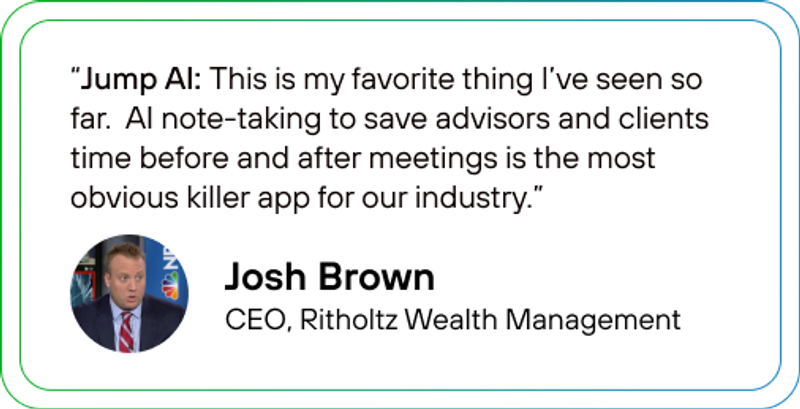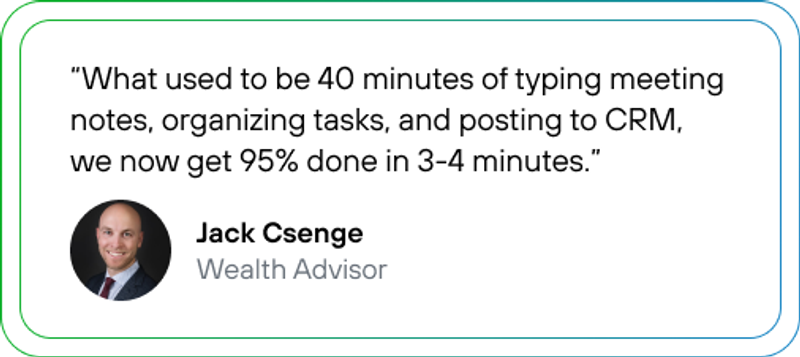Why AI Is the Key to Scalable Growth for Financial Advisors

As demand for personalized financial planning grows, so does one of the biggest pain points faced by financial planners and advisors: the expanding workload of pre- and post-meeting administrative tasks. Advancements in artificial intelligence (AI) offer powerful solutions to streamline tasks, manage vast amounts of data, and make financial advisory practices more efficient—all while freeing up advisors to more fully connect with their clients.
This blog post showcases how AI is helping financial advisors future-proof their firms by scaling services without sacrificing client relationships; how tools like Jump (an AI-powered note-taking solution) enable greater productivity; and addresses some common questions about AI’s role in finance, banking, and financial services.
AI and Scalability Challenges for Financial Advisors
Financial advisors are superheros in their own right, managing extensive client information, tracking market changes, complying with regulatory standards like SOC-2, and ensuring timely client communication—all while maintaining a solid relationship with the client, built on trust. Balancing these duties with the need to grow the client base can feel impossible without sacrificing service quality. Advisors report spending up to 40% of their time on non-billable tasks like documentation and scheduling, leaving less time for client engagement and financial planning.
This is where AI can be leveraged, enabling financial advisors to overcome scalability challenges without needing to hire additional staff. AI-powered tools like Jump assist with note-taking, legal document summaries, client communication tracking, and even predictive analytics—essentially providing the superheros with the “Ironman suit” needed to fully leverage their own superpowers. This level of automation allows advisors to dedicate more time to high-impact client interactions and relationship-building, while AI knocks out the lion’s share of time-consuming administrative work.
How Can AI Help Financial Services?
AI is transforming the financial services industry by driving efficiency, improving client service, and enhancing compliance and risk management. Here are some of the critical ways AI adds value, specifically to financial services:
- Data Management and Predictive Analytics: Financial institutions deal with vast amounts of constantly changing and evolving data. AI and machine learning analyze this data to provide insights that were previously impossible to derive manually during the course of a real-time conversation. For example, predictive analytics can identify patterns in a client’s financial behavior, allowing advisors to make better-informed decisions and discuss them in real time.
- Risk Management: AI-powered algorithms offer real-time data analysis, helping advisors assess predicted risk and guide clients toward safer investment options. This capability is especially important in managing portfolio volatility and ensuring financial strategies align with each client’s risk tolerance. This is something that can be best assessed when having a face-to-face conversation with a client where an advisor can more easily detect subtle changes in facial expressions and body language.
- Regulatory Compliance and Fraud Detection: Regulatory compliance is a significant concern in the financial sector—especially with the SEC—and AI can automate many compliance-related tasks, ensuring advisors remain compliant without spending hours on paperwork. Moreover, AI in banking is utilized to detect fraudulent activities by identifying unusual transaction patterns, safeguarding both advisors and clients from financial risk.
- Enhanced Financial Planning and Client Communication: Tools like Jump AI seamlessly plug into a firm’s existing tech stack to help keep client information organized and up-to-date, making it easy to access crucial data during client meetings. AI also facilitates tailored financial planning by analyzing a client’s goals and financial standing, allowing advisors to deliver more precise, customized recommendations.
Common Questions About AI and Financial Advisors
Will AI Replace Financial Advisors?
One of the most frequently asked questions is whether AI will eventually replace financial advisors. The short answer is: no. While AI can manage administrative tasks and analyze data at impressive speeds, it lacks the emotional intelligence and nuanced understanding needed for financial advising. Building client relationships, understanding individual financial goals, and providing emotional support during market downturns are areas where human advisors excel. AI, however, can significantly enhance an advisor’s superpowers, allowing them to serve more clients and provide better service.
How Do I Use AI as a Financial Advisor?
Financial advisors can use AI tools like Jump to streamline client communications, automate note-taking, and manage legal document summaries. Jump AI integrates with client relationship management (CRM) systems and the rest of a firm’s heavily relied-upon tech stack, allowing advisors to organize client data, analyze trends, and identify opportunities for more personalized service. By adopting AI solutions, advisors can improve efficiency, reduce manual workload, and offer high-quality service at scale.
What’s the Role of AI in Financial Services?
AI in financial services plays a critical role in data analysis, risk assessment, regulatory compliance, and enhancing client interactions and relationship development. By leveraging AI-powered solutions, financial institutions can improve operational efficiency, reduce costs, and create a data-rich, personalized client experience.
Key Benefits of Financial AI for Advisors
The benefits of AI in financial services are vast, especially when applied to the financial advisory field. Here’s a closer look at some tangible benefits:
1. Efficiency and Productivity
Jump AI can automate up to 90% of a financial advisor’s workload for meetings by managing routine tasks like data entry, compliance documentation, and appointment scheduling. AI tools such as Jump capture notes in real time, analyze meeting content, and organize data into actionable summaries. This results in significant time savings, allowing advisors to focus on high-value tasks, like advising clients on investment strategies and ensuring their needs and financial goals are met.
2. Improved Client Experience
Using AI in finance enables advisors to offer better client service. For instance, AI tools can analyze a client’s financial behavior and suggest personalized recommendations, enhancing the relevance of the advice provided. Advisors can also use AI-driven insights to conduct more meaningful, data-backed conversations, which clients increasingly value. Instead of furiously taking notes on a computer or a notepad, advisors can be fully engaged with their client, maintaining eye contact and thus much less likely to miss important cues like shifts in body language or facial expressions.
3. Scalability Without Compromising Service Quality
AI enables financial advisors to expand their client base without overextending themselves and sacrificing the time needed to develop a client-advisor relationship. By automating routine tasks and providing predictive analytics, advisors can deliver the same high level of service to a larger number of clients. This scalability is crucial for growth in competitive financial services markets, and to future-proofing any financial advising firm.
4. Risk Management and Compliance
AI tools help advisors discuss risk management with clients in real-time by rapidly analyzing client portfolios, highlighting potential risks, and recommending adjustments to mitigate those risks. Moreover, AI assists with regulatory compliance by automatically tracking and documenting necessary compliance steps, making it easier for advisors to meet legal requirements and protect against audit risks.
There are also data risks that are accelerated by generative AI. Yet another reason it is unlikely that financial advisors will ever be replaced by AI.
5. Fraud Detection
AI’s real-time monitoring capabilities are invaluable in detecting and preventing fraud. AI in banking is widely used to identify unusual patterns in transactions, which may indicate fraudulent activity. For financial advisors, this feature adds a layer of security, reassuring clients that their assets are being monitored and protected from potential threats.
Real-World Impact: How Jump Helps Financial Advisors Achieve Scalability
AI-powered tools like Jump are already making a measurable difference in the financial advisory field. By automating note-taking, document management, and client communication tracking, Jump helps advisors achieve significant productivity gains. Here are a few statistics that demonstrate the impact of using Jump:
- 40% reduction in time spent on routine administrative tasks, allowing advisors to dedicate more hours to developing client relationships and financial planning.
- 30% increase in client capacity, as advisors can handle a larger number of clients without sacrificing service quality and in fact, can more efficiently build a personal rapport with clients.
- Greater compliance efficiency with automated documentation and regulatory tracking, reducing the risk of compliance-related penalties.
Client testimonials underscore the value of these tools:

“Jump AI: This is my favorite thing I’ve seen so far. AI note-taking to save advisors and clients time before and after meetings is the most obvious killer app for our industry.” — Josh Brown, CEO, Ritholtz Wealth Management

“With Jump, what used to be 40 minutes of typing meeting notes, organizing tasks, and posting to CRM, we now get 95% done in 3-4 minutes.” — Jack Csenge, Wealth Advisor, Csenge Advisory Group
Ready to Scale Your Practice? Request a Personalized Demo
For financial advisors looking to grow their practice without compromising client service, adopting AI tools like Jump is the additional superpower you’ve been looking for. These tools enhance productivity, improve client satisfaction, and enable sustainable growth by automating repetitive tasks and providing valuable, actionable insights.
Ready to see how Jump’s AI-powered solutions can benefit your practice? Request a personalized demo today and discover the difference AI can make for your business.
Conclusion
The financial advisory industry is changing rapidly, and AI is the key to meeting increased demand without sacrificing the all-important client-advisor relationship. Rather than replacing financial advisors, AI is an invaluable tool that enables them to scale their practice while maintaining the quality of client interactions. By managing vast amounts of data, aiding in risk management, enhancing regulatory compliance, and automating mundane tasks, AI empowers advisors to deliver even better service while growing their client base, and maintaining a good working relationship with each client.
Investing in AI tools like Jump means future-proofing your practice with confidence. Embrace the potential of AI in finance and position yourself to meet the evolving needs of today’s clients.

About Jump
Jump AI is the leading AI meeting assistant, enabling RIA and Broker Dealer teams to cut meeting admin by 90% while elevating the advisor and client experience. Jump puts meeting prep, note taking, compliance documentation, CRM updates, client recap email, financial data extraction, and follow-up tasks on AI autopilot so advisors can process meetings in 5 min, not 60. Jump is made for advisors, 100% customizable, deeply integrated with the tech stack, and designed with safety and compliance in mind. For more information, visit https://jumpapp.com/.

